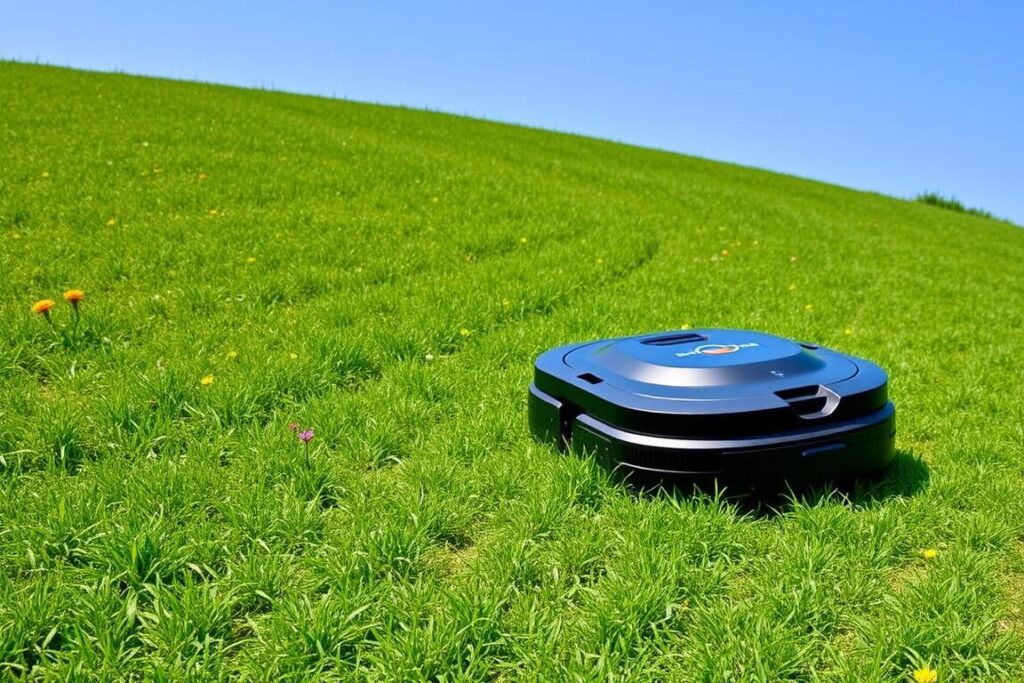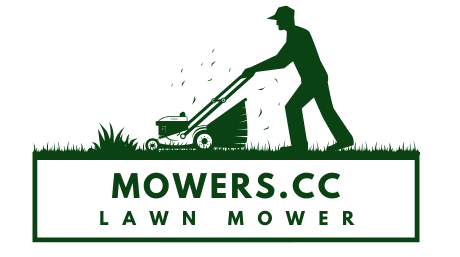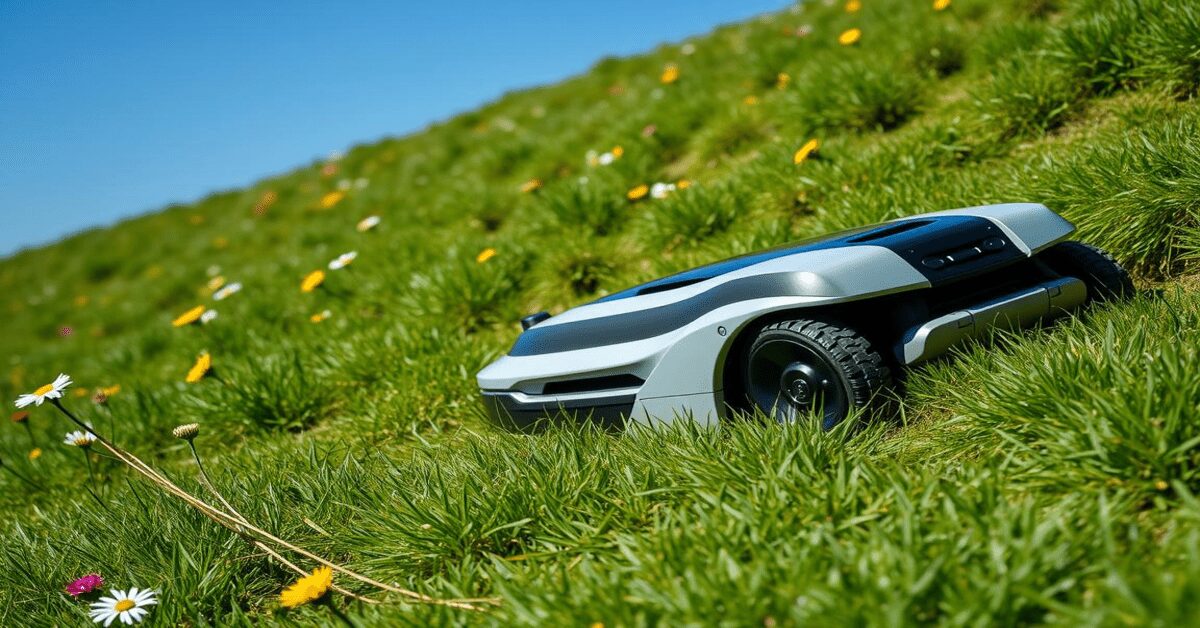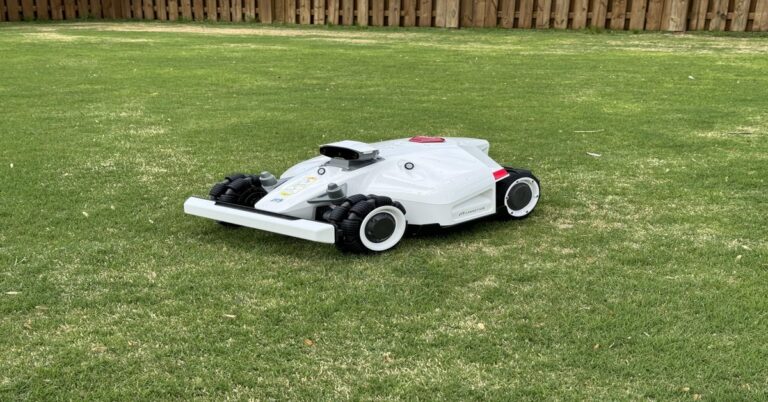Can Robotic Lawn Mowers Handle Slopes? Everything You Need to Know
Before we dive deeper into this topic, we’ve included a podcast discussion with experts. They share their insights and experiences on how robotic mowers handle slopes. Tune in to hear real-world tips and advice before continuing with the guide!
Dealing with a sloping lawn can be tough. But, thanks to new robotic lawn mower tech, you can have a beautiful garden without hard work. But, how well do these mowers do on uneven and steep areas? This guide will show you what robotic lawn mowers can do on slopes. We’ll look at the important features and things to think about for easy and effective mowing on hills.
Key Takeaways
- Robotic lawn mowers can handle slopes up to 35°-45° with the right features and specifications
- All-wheel drive (AWD) models offer enhanced maneuverability and traction on steep inclines
- Slope control and terrain sensors help robotic mowers adapt to changing gradients
- Proper boundary and guide wire installation is crucial for safe and efficient mowing on slopes
- Regular maintenance, including wheel cleaning and terrain kit usage, is essential for optimal performance on sloping lawns
Table of Contents
ToggleChallenges of Mowing on a Slope
Mowing on a slope is tough. It puts more stress on your lawn mower than flat ground does. You need more power to handle uneven terrain, which wears out the motor and blades faster.
Power Requirements and Wear on Equipment
The mower’s parts work harder on slopes. This means the blades and motor wear out quicker. The mower’s life gets shorter because it has to work harder to stay on track.
Calculating Slope Gradient for Your Garden
To find your garden’s slope, use two yardsticks. Hold one stick flat and measure down to the ground with the other. This tells you the slope percentage and angle in degrees.
- For example, a 12-inch distance means a 50% slope or a 26.6-degree angle.
- Steep slopes over 45 degrees need special commercial mowers for safe mowing.
Knowing your garden’s slope is key. It helps pick the right mower for safe and efficient mowing.
Robotic Lawn Mowers: The Ideal Solution for Slopes
Robotic lawn mowers are perfect for mowing slopes. They can handle slopes up to 35°-45° safely. This makes them a great choice for those who want to avoid the dangers of manual mowing on steep areas.
These robotic mowers for slopes are designed to move on hills easily. They have strong motors and special systems to keep them stable. This means you can mow your hilly yard without worrying about the hard work or safety risks of gas mowers.
- Robotic mowers can handle slopes of up to 35°-45° with minimal risk of accidents or equipment damage.
- Their self-propelled design and superior traction make them well-suited for mowing on steep terrain.
- Intelligent slope control features, such as incline sensors and adjustable power settings, ensure optimal performance on inclines.
Getting a robotic lawn mower for hilly terrain makes lawn care easy. These machines are not only good for slopes but also make lawn care safer and more efficient.
Choosing the right robotic mower for slopes is important. Talk to experts at Autmow to find the best one for your yard. With the right mower, you can have a beautiful lawn without the hassle, even on tough terrains.
Slope Capabilities of Robotic Mowers
Robotic mowers can handle many slope inclinations. The maximum slope they can manage varies by model. Standard models can go up to 25%. But, newer models can handle steeper slopes of 35% or even 50%.
Manufacturer Specifications for Slope Inclination
High-end models like HUSQVARNA’s Automower 435X AWD and Automower 535 AWD can handle up to 70% gradient. This is as steep as a black diamond ski slope. The mower’s ability to climb steep slopes depends on its engine, weight, number of wheels, and wheel design.
Always check your robotic mower’s operator’s manual for its slope capabilities. Manufacturer data might be optimistic and based on ideal conditions.
| Robotic Mower Model | Maximum Slope Inclination |
|---|---|
| HUSQVARNA Automower 435X AWD | 70% |
| HUSQVARNA Automower 535 AWD | 70% |
| Standard Robotic Mowers | 25-50% |
Key Features for Mowing on Slopes
Robotic mowers need special features to handle slopes well. These include traction wheels, strong motor power, and all-wheel drive.
Traction Wheels and Grip Enhancement
Robotic mowers for slopes have bigger, better traction wheels. They give a firm hold on uneven, slippery ground. The bigger surface and special tread help the mower stay steady on hills.
Motor Power and Battery Capacity
Mowing slopes needs more power than flat ground. This means the mower can cover less area per charge. So, robotic mower features for slopes need strong motors and big batteries for efficient mowing.
All-Wheel Drive vs. Front or Rear-Wheel Drive
All-wheel drive robotic mowers are better on slopes than others. They have better traction wheels for slopes. This lets the mower control and move up steep hills well. It’s great for tough terrain with different slopes.
Inclination Sensors and Intelligent Software
Robotic lawn mowers have cool features for mowing on slopes. They use robotic mower slope sensors to measure the slope. This helps them adjust their mowing to stay safe and efficient.
The intelligent slope control software in these mowers quickly responds to slope changes. If a slope gets too steep, the mower turns to avoid it. It also uses automated slope navigation to carefully go down steep hills. This keeps it in control and stops it from rolling away.
These sensors and smart algorithms are key for robotic mowers to safely handle slopes. They watch the slope and adjust in real-time. This lets them handle tough outdoor areas with ease and accuracy.
For example, the Yarbo Lawn Mower can handle slopes up to 35 degrees. The Husqvarna Automower 435X AWD can even go up to 70 percent. Their advanced sensors and smart software make this possible.
By adding robotic mower slope sensors, intelligent slope control software, and automated slope navigation, makers let mowers tackle tough hills. This gives homeowners a simple and effective way to mow their lawns.
Boundary and Guide Wire Installation for Slopes
Installing boundary and guide wires for robotic lawn mowers on slopes is different for standard and all-wheel drive (AWD) models. Knowing these differences is key for the mower’s best performance and efficient coverage of your sloped lawn.
Standard Robotic Mower Models
For standard models, lay the boundary wire on flat ground before the slope. This helps the mower detect the area’s edges accurately. The guide wire should go diagonally across the slope. This guides the mower up the incline smoothly.
All-Wheel Drive (AWD) Robotic Mower Models
AWD models have better traction and mobility on slopes. You can place the boundary wire closer to the slope. The guide wire can go straight from the bottom to the top of the slope. This makes installation easier.
Proper boundary wire installation for slopes and guide wire layout for slopes are vital. They ensure your robotic mower can handle sloped terrain well. Knowing the differences between standard vs. AWD robotic mower setup helps get the best lawn care results.

Robotic lawn mower on slopes
Robotic lawn mowers are made to handle slopes and tough terrain. They have strong motors, big wheels, and smart software. This lets them move and cut grass on hills safely and well.
These mowers can handle steep slopes. Some can go up to 24 degrees or more. Models like the Husqvarna Automower® 435X AWD and the Ambrogio QUAD Elite can even go up to 70% or 75% slopes.
They adjust to the terrain to keep the grass even. This means they can cut the grass at the same height and speed on hills. They do this by changing their wheels, motor power, and how they cut the grass.
When picking a mower for hills, check the slope it can handle. The Husqvarna Automower® 435X AWD, Husqvarna 535 AWD, and Ambrogio QUAD Elite are great for slopes. They have better grip, power, and navigation.
Choosing the right mower and installing it right lets you have a great-looking lawn on hills. Robotic mowers are perfect for keeping your lawn lush and healthy on slopes.
Optimizing Mower Settings for Slopes
Mowing on slopes can be tough, but the right settings can help. Many robotic mowers have a “Slope Control” feature. This makes the mower work better on steep areas, keeping your lawn looking great.
Slope Control and Performance Modes
Some mowers also have special modes for different slopes. These modes change things like power and height to fit the terrain. This means your mower will do its best on hills and slopes.
For example, Husqvarna mowers can handle slopes up to 45%. But cheaper models might only go up to 25%. It’s important to know your mower’s limit to keep it safe and working well.
| Mower Model | Maximum Slope Inclination |
|---|---|
| Husqvarna Automower 115H | 35% |
| WORX Landroid L 20V WR150 | 20% |
| Gardena R40Li | 25% |
Adjusting your mower’s settings for slopes is key. It helps your mower last longer and your lawn look perfect, even on tough terrain.
Maintenance Tips for Slope Mowing
Keeping your robotic lawn mower in top shape is key, especially for slopes. Focus on cleaning the wheels and using terrain kits to ensure smooth operation on inclines.
Cleaning Wheels and Using Terrain Kits
Grass and debris can build up on your mower’s wheels, making it harder to move on slopes. Cleaning the wheels regularly is crucial for maintaining grip and stability. Many mowers come with terrain kits for better performance on slopes. These kits include heavy-duty rear wheels and wheel brushes.
Always check your mower’s manual for the best way to clean wheels and use terrain kits. Proper care can greatly improve your mower’s ability to handle slopes.
| Maintenance Tip | Benefit |
|---|---|
| Cleaning Wheels | Improves traction and stability on slopes |
| Using Terrain Kits | Enhances grip and performance on inclines |
By following these tips and using the right accessories, your robotic mower will work its best on slopes. This means a well-kept lawn with less effort from you.
Alternatives to Robotic Mowers for Slopes
Homeowners with sloped lawns might find robotic mowers not the best fit. These devices can handle some inclines but struggle with very steep ones. Luckily, there are other ways to mow hilly areas.
Manual Lawn Mowers for Slopes
Manual lawn mowers are great for sloped lawns. They are light and easy to push up hills. They also offer more control, perfect for small yards with obstacles.
Power Scythes for Slope Mowing
A power scythe is good for big, wild areas on slopes. It cuts through thick grass and weeds well. It gives a natural look, unlike a regular mowed lawn.
Lawn Tractors for Slopes
For big, sloped yards, a lawn tractor is a good choice. They can handle slopes up to 15-20 degrees. They are powerful and stable, better than manual or robotic mowers for large areas.
Choosing the right mower for slopes depends on your yard’s size, slope, and plants. By looking at your yard and needs, you can pick the best way to keep your lawn looking good.
| Mower Type | Suitable Slope Range | Cutting Width | Ideal Lawn Size |
|---|---|---|---|
| Manual Lawn Mower | Up to 20 degrees | 12-21 inches | Up to 0.5 acre |
| Power Scythe | Up to 30 degrees | 16-24 inches | 0.5-2 acres |
| Lawn Tractor | Up to 20 degrees | 42-54 inches | 1-2 acres |
Redesigning Your Landscape for Easy Maintenance
Regular mowing on slopes can be a big hassle. Homeowners might want to think about changing their landscape instead. They could use stone walls, stairs, and flower beds to make their slopes look good. Or, they could switch to a low-maintenance meadow that needs only a few cuts a year.
Changing your landscape for easy maintenance means using plants that need little care. Native plants or groundcover are great for this. Rock gardens, terraced beds, or mulch paths can also cut down on mowing and trimming.
Homeowners can also use retaining walls, tiered planting, or drought-resistant plants to manage slopes. This way, they can enjoy a beautiful outdoor space without all the hard work. A well-designed landscape is both beautiful and easy to keep up with.
FAQ
Can robotic lawn mowers handle slopes?
Yes, robotic lawn mowers can handle slopes well. They can mow lawns with slopes up to 35°-45°. This makes mowing safer than doing it by hand.
What are the challenges of mowing on a slope?
Mowing on a slope needs more power. The blades work harder on uneven ground. This can wear them out faster and shorten the mower’s life.
How do I calculate the slope gradient of my garden?
To find the slope gradient, use two yardsticks. Hold one stick horizontally and measure the distance to the ground with the other. This tells you the slope percentage and angle.
What are the key features of robotic mowers for mowing on slopes?
Robotic mowers for slopes have big, grippy wheels and strong motors. They also have smart software that adjusts to the slope. Some even have all-wheel drive for better grip on steep slopes.
How do I install the boundary and guide wires for robotic mowers on slopes?
For standard mowers, lay the boundary wire flat before the slope. The guide wire goes diagonally across. AWD models can have the boundary wire closer to the slope, and the guide wire straight up.
What maintenance is required for robotic mowers on slopes?
Keep the mower’s wheels clean to help it grip the slope. Many makers offer terrain kits with heavy-duty wheels and brushes for better traction.
What are some alternatives to robotic mowers for mowing on slopes?
For sloped lawns, you can use hand mowers, power scythes, or lawn tractors for gentle slopes. You can also change your landscape to need less mowing on steep areas.


